Teaching Machines Empathy: The Human Lessons in War Literature
The Human Cost of War: Beyond Numbers
“You must never forget how to feel.” —The Nightingale.
Wars begin with flags and end with numbers. Between those numbers lie millions of unseen stories: the woman waiting for a husband who never returns, the boy who forgets his father’s face, the soldier who cannot tell whether he is fighting for justice or survival. When war loses its principles, it destroys more than cities; it destroys the human capacity to feel another’s pain. That is what makes war so devastating—not only the violence, but also the erosion of empathy itself.
In every age, literature has tried to remind us of this truth. Histories record battles and treaties, but novels carry what data cannot: the heartbeat of human experience. They turn statistics into faces and faces into memories.
In Gone with the Wind, The Nightingale, and Half of a Yellow Sun, war is not the backdrop; it is the atmosphere that seeps into every conversation, gesture, and dream. These stories show that the first casualty of war is not life; it is compassion. What connects these novels, despite their different geographies, is how they portray ordinary people caught in extraordinary cruelty.
the Scarlett O’Hara clings to survival amid ruins of pride and privilege; Vianne Mauriac risks everything to protect strangers in a world that rewards betrayal; Olanna and Ugwu in Half of a Yellow Sun watch love and morality unravel in the heat of the Biafran War. None of them are heroes in the conventional sense. They are human, flawed, frightened, and capable of both mercy and cruelty. And that is precisely the lesson war literature offers: when morality collapses, the test of humanity begins.
When pain becomes routine, empathy fades. That is as true in war as it is in our modern age of information. We scroll past suffering, seeing it only as data, as distant and weightless as smoke. The human mind numbs itself to survive; the human system rationalizes to move on. But every time we reduce suffering to numbers, we repeat the logic of war, the logic that counts casualties instead of acknowledging lives.
Fiction restores what war erases. It turns abstract suffering into intimate recognition. A single child crying in a bombed village speaks more to our conscience than a thousand-line report on destruction. Literature asks us not to analyze but to imagine. To inhabit another person’s fear. To hold the gaze of grief until it becomes unbearable and still not look away.
Literature as a Guardian of Empathy
In a world increasingly shaped by artificial intelligence, I wonder if machines will ever understand this kind of feeling. Can they? Can systems trained on patterns and probabilities comprehend the moral chaos of human experience?
Can they recognize the tremor in a sentence, the hesitation that hides a lifetime of pain? AI can summarize Half of a Yellow Sun in seconds, but can it sense the silence between Olanna’s words when she loses her family? It can list every battle in Gone with the Wind, but can it feel the emptiness when Scarlett says, “After all, tomorrow is another day”? Machines can learn to speak, but can they learn to care?
The irony is sharp. The more we teach technology to think, the more we risk forgetting to feel. We design systems that can read emotion but not experience it. They can detect sentiment in a line of text, but not the weight of memory it carries. When we build AI models using only data, we replicate our own detachment. We make them fluent in language but illiterate in empathy. Perhaps literature offers an antidote, a reminder, or even a model for how to reintroduce empathy into intelligence. What if, instead of training AI solely on information, we also trained it on imagination? What if, alongside datasets, we fed it the world’s stories and narratives that contain moral contradictions, emotional ambiguities, and ethical dilemmas? Not to make machines human, but to help them mirror the complexity of being human.
AI, Data, and the Limits of Understanding
Imagine an intelligent system that learns from the moral fabric of stories, from the guilt of survival in The Nightingale, from the loss of innocence in Gone With the Wind, and from the shared hunger and compassion in Half of a Yellow Sun. Such a system might begin to see that meaning is not in data, but in context. That truth is not numerical but relational. That morality exists in the spaces between right and wrong, the same spaces literature teaches us to navigate.
We don’t expect machines to feel, but we can teach them to recognize the texture of feeling, to pause before responding, to weigh not just information but implication. In design terms, empathy could be built not as emotion, but as “awareness”: a sensitivity to context, tone, and consequence. That awareness might make technology less efficient but more ethical. And perhaps that is what the future most needs: intelligence that is wise enough to hesitate.
This is not a sentimental wish. It’s a practical rethinking of what it means to create technology in the image of its makers. For centuries, art and literature have been humanity’s moral testing grounds, spaces where we confront cruelty, guilt, and forgiveness before they shape the real world. Why shouldn’t AI, the next great invention of our species, learn from those same spaces? If it must mirror our thinking, let it mirror our capacity for reflection too.
Because when we remove emotion from intelligence, we end up with precision without purpose machines that can calculate sorrow, but never console it. When we separate morality from progress, we repeat the same blindness that war reveals: the belief that power is its own justification. Literature shows us that every system, no matter how advanced, must remember the fragile heartbeat of its creators. War literature, then, is not only a record of suffering. It is a warning about forgetting.
It tells us what happens when ideology replaces empathy, when people stop recognizing themselves in the faces of others. In those moments, humanity becomes something we can lose. And if machines are to inherit our ways of thinking, they must first inherit our ways of remembering. To remember means to see the world through another’s eyes to understand that each statistic conceals a story, and each story conceals a soul. That is the essence of both morality and intelligence. The novelist and the engineer, in their own ways, are builders of systems: one of imagination, the other of logic. But only one begins with empathy. The other must learn it.
Conclusion: Preserving Humanity in an Age of Machines
When I read Half of a Yellow Sun, I am reminded that empathy is not a feeling; it is an act of courage. To witness suffering and still remain open is to resist the numbness that war demands. To teach a machine even a shadow of that is to teach it the beginning of wisdom. Because wisdom, unlike data, requires conscience.
Maybe machines will never feel. Maybe they shouldn’t. But we can still design them to respect what feeling means, to understand that human life cannot be reduced to a dataset, and that the space between words can hold more truth than words themselves.
The lesson is not to make machines emotional, but to keep ourselves human. War teaches us how easily empathy can vanish. Literature teaches us how to bring it back. And together, they remind us of our most essential responsibility to never let intelligence, no matter how advanced, forget the heart that built it.
“In love we find out who we want to be; in war we find out who we are ” The Nightingale.


.jpg)






